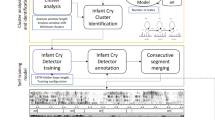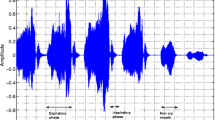Abstract
The detection of cry is crucial in intelligent computerized systems that aim at assessing the well-being of neonates during their hospitalization periods. Moreover, a precise characterization of cry allows its classification (e.g., hunger, pain, tiredness…). Although several cry detection and characterization techniques can be found in the literature, there is no testing of such techniques in real-life environments such as hospital intensive care units. In this article, we first summarize the problem of background noise in intensive care units that may prevent the operation of cry detection algorithms from succeeding. Second, we implement a specific cry detection technique that is based on some of the relevant cry detection proposals that have been found in the literature. Finally, we test this method using audio samples recorded in a real neonatal intensive care unit.
Access this chapter
Tax calculation will be finalised at checkout
Purchases are for personal use only
Similar content being viewed by others
References
Nidcap.org, A.: What is NIDCAP?—NIDCAP. http://nidcap.org/en/families/what-is-nidcap/ (Retrieved 13 January 2017).
Martinez-Ballesté, A., Casanovas-Marsal, J. O., Solanas, A., Casino, F., & Garcia-Martinez, M., A.: An autonomous system to assess, display and communicate the pain level in newborns. In Medical Measurements and Applications (MeMeA), 2014 IEEE International Symposium on. p. 1–5. IEEE, 2014.
Shoemark, H., Harcourt, E., Arnup, S. J., & Hunt, R. W., A.: Characterising the ambient sound environment for infants in intensive care wards. Journal of paediatrics and child health, 52.4, 436–440 (2016).
Almadhoob, A., & Ohlsson, A., A.: Sound reduction management in the neonatal intensive care unit for preterm or very low birth weight infants. The Cochrane Library (2015).
Darcy, A. E., Hancock, L. E., & Ware, E. J, A.: A descriptive study of noise in the neonatal intensive care unit ambient levels and perceptions of contributing factors. Advances in Neonatal Care, 8(3), 165–175 (2008).
Manfredi, C., Bocchi, L., Orlandi, S., Spaccaterra, L., & Donzelli, G. P., A.: High-resolution cry analysis in preterm newborn infants. Medical Engineering and Physics, 31.5, 528–532 (2009).
Cohen, R., & Lavner, Y, A.: Infant cry analysis and detection. In Electrical & Electronics Engineers in Israel (IEEEI), 2012 IEEE 27th Convention of. p. 1–5, IEEE (2012).
Díaz, M. A. R., García, C. A. R., Robles, L. C. A., Altamirano, J. E. X., & Mendoza, A. V., A.: Automatic infant cry analysis for the identification of qualitative features to help opportune diagnosis. Biomedical Signal Processing and Control, 7.1, 43–49 (2012).
Reyes-Galaviz, O. F., Cano-Ortiz, S. D., & Reyes-García, C. A., A.: Evolutionary-neural system to classify infant cry units for pathologies identification in recently born babies. In Artificial Intelligence, 2008. MICAI’08. Seventh Mexican International Conference on. p. 330–335. IEEE (2008).
Acknowledgements
This paper was completed by financial supporting from VAST project (Vietnam Academy of Science and Technology): “Design and development of a remote visual monitoring system applied for security applications” which project’s code is: VAST01.10/17-18. Authors also thank Hospital Universitari Joan XXIII and the personnel in its neonatal intensive care unit for allowing them the recording of audio samples in their facilities. Finally, we like to thank Dr. Carlos A. Reyes-Garcia, Dr. Emilio Arch-Tirado and his INR-Mexico group, and Dr. Edgar M. Garcia-Tamayo for their dedication to the collection of the infant cry data base.
Author information
Authors and Affiliations
Corresponding author
Editor information
Editors and Affiliations
Rights and permissions
Copyright information
© 2018 Springer Nature Singapore Pte Ltd.
About this paper
Cite this paper
Dang, M.C., Martínez-Ballesté, A., Pham, N.M., Dang, T.T. (2018). On the Robustness of Cry Detection Methods in Real Neonatal Intensive Care Units. In: Bhateja, V., Nguyen, B., Nguyen, N., Satapathy, S., Le, DN. (eds) Information Systems Design and Intelligent Applications. Advances in Intelligent Systems and Computing, vol 672. Springer, Singapore. https://doi.org/10.1007/978-981-10-7512-4_12
Download citation
DOI: https://doi.org/10.1007/978-981-10-7512-4_12
Published:
Publisher Name: Springer, Singapore
Print ISBN: 978-981-10-7511-7
Online ISBN: 978-981-10-7512-4
eBook Packages: EngineeringEngineering (R0)




